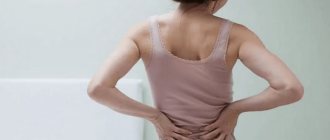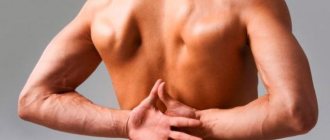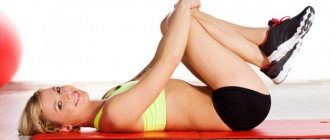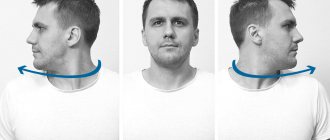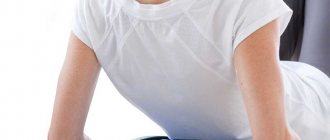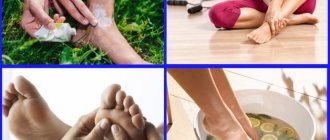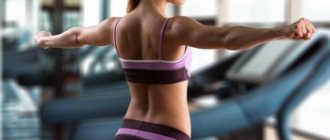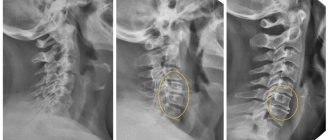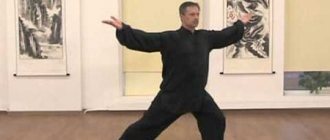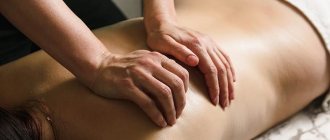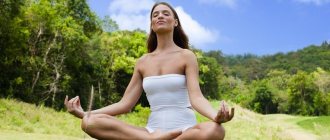Unfortunately, today the diagnosis of osteochondrosis is made, most often, only on the basis of patient complaints and X-ray and ultrasound data, and the elimination of pain is very often confused with the restoration of health. At the same time, such important indicators as the functional state of the muscles and ligamentous apparatus are absolutely not taken into account. And this is all the more strange, since osteochondrosis of the cervicothoracic spine in almost 100% of cases is accompanied by excessive tension in the paravertebral muscles of the cervical and thoracic regions, insufficient mobility of the shoulder and elbow joints, weakness of the back muscles, etc. With the traditional approach, the treatment of osteochondrosis of the cervicothoracic region is drug therapy, restriction of movement or surgical treatment with subsequent disability and mandatory limitation of work ability.
The essence of the doctor’s methods and the advantages of therapeutic exercises
The set of exercises is designed in accordance with the age and anatomical characteristics of the joints and spinal column.
It is aimed at uniform load on all parts of the spine, which has a beneficial effect on muscles, ligaments, vertebrae and joints. It is therapeutic exercises for the spine that ensure blood flow to the muscles and tissues of the joints, providing them with elasticity, flexibility, mobility and tone. The set of exercises is designed to gradually load the muscles. Advantages of Bubnovsky’s therapeutic gymnastics:
- Taking into account all the characteristics of the human body.
- Uniform load on muscles, joints, vertebrae and ligaments.
- Providing nutrients and oxygen to muscles and tissues.
- Improving metabolic processes in tissues and muscles.
- Providing a boost of energy, vigor and good mood.
- Increased mobility, elasticity, tone and appearance of joints, muscles, vertebrae.
- The exercises can be done independently at home.
Standard set of exercises
This complex is most suitable for those who have entered the stage of remission, as well as for intervertebral hernias.
The complex involves performing the following exercises:
1. "Spring". Body position - standing with arms down along the body. Slowly tilt your head forward and hold in this position for a few seconds. Then bend back with your chin up. Again there is a delay of a few seconds. Return to starting position.
2. "Review". The starting position is the same. Slowly turn your head to the side and hold the pose. Then turn in the other direction. The exercise should be repeated three times on each side.
3. "Metronome". Tilt the head first to one side, then to the other. Delay in each position for 30 seconds. It is necessary to do 6 tilts in each direction.
4. "Goose". Starting position - standing with your hands on your belt, your chin should be aligned parallel to the floor. By stretching it forward and turning your head, you need to place your chin on your shoulder. The body turns along with the head. You should spend up to a minute in this position. Then change sides. Repeat the exercise 6 times in each direction.
5. "Heron". The exercise must be performed while sitting on a chair with your head straight and your palms on your knees. The arms are straightened and moved to the sides, the head is simultaneously thrown back. Then return to the starting position. The exercise should be done slowly and smoothly.
6. “Complicated review.” The starting position is like in the “heron”. Turn the head to the right, the palm of the left hand is placed on the right shoulder so that the elbow is at a right angle. After returning to the starting position, repeat in the other direction. In an advanced stage of osteochondrosis, a specific sound may appear in the spine during the exercise.
7. "Fakir". Sitting on a chair, raise your arms above your head and bend them slightly. Turn your head all the way and stay in this position. Repeat on the other side.
Treatment of cervical osteochondrosis at home according to Bubnovsky is quite simple. This set of exercises is easy to perform and gives visible results after some time - discomfort in the neck disappears and mobility is restored. The attending physician should prescribe exercises after a thorough examination and correct diagnosis. If acute pain occurs during exercise, you should stop exercising and consult a doctor.
How effective is the treatment of cervical osteochondrosis using the Bubnovsky method?
Basic rules of training
Performing physical therapy for thoracic osteochondrosis requires compliance with certain rules, on which the quality of the training and its safety will depend.
When doing exercise therapy, you should know that gymnastics should improve your well-being, and if the opposite effect is observed when performing it and the body’s condition does not improve within 7 days, then you should consult a doctor and reconsider the training.
Where do you need to start?
- Exercises are prohibited during the acute stage; it is recommended to exercise during the period of remission.
- At first, the exercises are performed without additional weight, but after a few weeks, when the body gets used to the stress, you can use special sticks, weights, and elastic bands.
- The number of approaches increases gradually. For the first workout, 5-7 repetitions will be enough, then increase to 12.
How to do it correctly?
Physical therapy is not an active sport, so all exercises are done at a slow pace without sudden movements. During classes you need to monitor your well-being. If it has sharply worsened, then you need to greatly reduce the intensity of exercises and eliminate those that provoke deterioration. In this case, it is not recommended to quit training.
Bubnovsky’s gymnastics for hernia
The Bubnovsky system of exercises for spinal hernia helps to reduce hernial formation, reduces pain, and improves general condition.
The essence of the exercise technique for hernia is as follows:
- complete relaxation of muscle fibers. This relieves inflammation, swelling, pinched nerve endings leading to pain;
- working out all (including deep) muscles. Blood circulation and metabolism in pathological areas improves;
- stretching muscles and spine. Increases muscle elasticity, straightens the spinal axis, and returns the vertebrae to an anatomically determined location;
- strengthening the muscular framework of the entire spinal column. It is achieved through exercises not only to strengthen the muscles of the abs, pelvis, back, but also through the use of legs and arms.
Important! The main condition of therapeutic gymnastics according to Bubnovsky is the complete absence of medications. This determines the effectiveness of the exercises, and a decrease in pain usually appears after several sessions.
Indications for use
Bubnovsky’s therapeutic exercises are aimed at improving the motor ability of joints and are indicated in the following cases:
- for any pathologies of knee joint mobility;
- with impaired mobility of the spinal column;
- at the initial stages of arthrosis development;
- in the presence of destructive processes in the vertebrae at the initial stage of their formation.
In addition, exercises are effectively used at the recovery stage after diseases associated with inflammation, as well as after injuries and damage during the rehabilitation stage.
At what stage can Bubnovsky gymnastics be performed?
Did you know that...
Next fact
Bubnovsky gymnastics can begin to be performed at the first stage of development of the pathological process. Even with minor pain, it is necessary to perform exercises so that the disease does not develop further.
If there is an inflammatory process, you should first relieve the inflammation, and then you can begin to perform gymnastic exercises.
Read the following related material:
- Advantages and disadvantages of neck gymnastics using Dr. Bubnovsky’s method
- What contraindications and restrictions exist for vertebral hernia, you will find out here
- What physiotherapeutic methods are used to treat spinal hernia can be found on the page https://spinatitana.com/pozvonochnik/drugie-zabolevaniya/mezhpozvonochnaya-gryzha/fizioterapiya-pri-gryzhe-pozvonochnika.html
Indications and contraindications for use
Therapeutic massage, like any therapeutic effect, is prescribed only in certain cases and is unacceptable in the presence of acute conditions or chronic pathologies. The decision on the advisability of using this technique is made by the attending physician based on the results of tests and instrumental studies (CT, MRI). Massage is needed in the following cases:
- Muscle leakage.
- Stiffness when moving.
- Vascular disorders.
- Severe pain syndrome.
- Pinched nerve fibers.
- Exit from the sciatic nerve.
- Scoliosis or degenerative changes in cartilage tissue.
- Injured muscles or ligaments.
- Impaired spinal flexion.
Therapeutic massage of the spine is carried out at all stages of pathology development, except for the acute stage. Performed at the site of pain. This is very beneficial in the stage of complete remission or consolidation of positive dynamics. The duration of the course largely depends on concomitant pathologies, as well as on the general condition of the patient.
The main contraindications to the use of any massage techniques are:
- Development of a herniated disc with the risk of compression of the spinal canal.
- Infectious processes or inflammation of soft tissues.
- Tumor formation.
- Serious damage to the nervous system.
- Postoperative period.
- Exacerbation of any chronic pathology.
- Open skin lesions, rashes, fungus, abrasions or eczema.
- Disruption of normal blood flow due to varicose veins or vascular pathologies.
- History of heart attack or stroke.
- Blood diseases.
- Fever or cold.
In such cases, external influences can adversely affect the course of the pathology and cause complications. Before prescribing a massage, the doctor checks whether there are any contraindications.
How to cure cervical osteochondrosis? How to treat a herniated disc without surgery? Bubnovsky's answers
Video text
Professor, Doctor of Medical Sciences, author of a fundamentally new system for restoring work capacity and relieving pain without drugs and operations, Sergei Bubnovsky answers questions from channel subscribers.
5:17 Hernia of the spine is a myth created by neurosurgeons. This is not a disease or the cause of back pain. A hernia is the “aging” or wear and tear of the spine. The weakest part is the intervertebral discs, which are cartilage that simply wears away. It is a mistake to think that a hernia pinches some nerves
Bubnovsky draws attention to the fact that if a nerve were pinched, there would be paralysis of the limb
12:21 Is it necessary to have surgery for a 12mm hernia, absolute stenosis, numbness of the right foot? Should I have surgery for a herniated disc?
Spinal stenosis is a myth. Some MRIs show a sequestered hernia. Such a hernia is already dead tissue; it cannot close any canal. The lumbar spine is its most strengthened part; there are no nerves there. The cause of the pain is not a hernia, but muscle spasms. After any surgery on the spine, there is a high probability that the person will be disabled and will remain in this condition forever. If you choose and perform the exercises correctly, then you can get rid of pain and swelling and become healthier than you were, cure a herniated disc without surgery.
17:17 An 8-year-old girl has hip dysplasia - how to treat it, what are the recommendations?
Children under 20 years of age do not need to undergo surgery. It is now very fashionable to call any curvature dysplesia. Often, for hip dysplasia in children, orthopedists prescribe splints, corsets, etc., which further aggravates the child’s condition. This leads to early disability.
19:00 How to cure cervical osteochondrosis?
Cervical osteochondrosis is a matter of myofascial diagnosis. There are exercises that restore blood flow in the cervical spine. How to cure cervical osteochondrosis? You can read more about the exercises in the book “Osteochondrosis of the Spine.” It describes exercises for the cervical, thoracic and lumbar spine. I do not recommend twisting your hands or using various manual means. It is much more effective to use special simulators.
21:45 Why in ground gymnastics the first part is strength.
Parterre gymnastics does not apply to kinesitherapy. This is a separate product for people who cannot come to the Bubnovsky center and cannot buy a trainer. Such gymnastics does not cure, but helps maintain health at the proper level. There are three parts to gymnastics: strength, stretching and aerobic. You can change parts, but it is better to stick to this sequence. Total duration – 1 hour.
24:40 Male, 32 years old, overweight, it seems that the spine is curved, the shoulder is higher than the other, I am doing general physical training, am I doing the right thing?
OPS itself does not cure, correct exercise cures it
The most important thing is proper breathing during exercise and stretching. It is very difficult
Those. This is not breathing exercises, but proper breathing control. Then it will make sense.
29:50 How to sleep with scoliosis, how to eliminate back asymmetry?
If you have scoliosis, you should sleep on orthopedic mattresses. There are different types of scoliosis, first you need to figure out what kind of scoliosis you have. Scoliosis must be dealt with throughout your life so that it does not twist you.
Have you decided to take care of your health? Right now:
1⃣ Subscribe to our channel https://www.youtube.com/BubnovskyTV/. 2⃣ Get a free online course by Bubnovsky https://vk.cc/8simJO3⃣ Read books and watch Bubnovsky’s CDs https://vk.cc/8sio9W4⃣ Sign up for seminars with Bubnovsky https://vk.cc/8siouJ5⃣ Book a consultation with us https https://vk.cc/8sioUv
Hotline number for back and joint pain 8-800-222-35-92
How to massage with osteochondrosis
The therapeutic massage technique consists of a series of sequential influences. Before starting treatment, the body should be prepared and warmed up. All movements are made in the direction of blood flow.
- Make 3-4 light, even movements without pressure.
- Start sanding and make 3-4 simple circular motions.
- Complete the warm-up by cutting out the edge of your arms (2-3 repetitions). Make longitudinal and perpendicular cuts along and across the back.
- Using both hands, fold the muscles and skin into a fold and move them from the bottom (from the base of the lower back) up (to the base of the neck).
- Use your fingertips to alternately massage the longitudinal and transverse muscles.
- Tap the surface of the body with your fingers and the edge of your hand.
- In the boat, pat the skin with your hand.
- Run your fingers along the intercostals to the shoulder blades.
- Using the heels of your hands, perform a spiral squeeze in a circular motion along the body. It's as if you are rubbing the cream into the skin as deeply as possible.
After a thorough back massage on both sides, proceed to a classic neck and collar massage. Do also the procedures for 3-5 repetitions. Since the neck is a delicate anatomical area, all movements should be performed with extreme care and strength. The main effects are stroking, rubbing on the sides and circular kneading.
- Rub your hands over the collar area, such as your back, to warm up, stretch and prepare for the massage.
- Next, cut from the shoulder blade to the skull with the edge of your hand. Don't press too hard; the skin here is more sensitive than on your back.
- Using the heel of your hand or the pads of your thumbs, squeeze the skin near the cervical spine from the shoulder blades to the skull.
- From the shoulder to the skull, alternately do spiral compressions with your hands, as in the back.
- Using the pads of your thumbs, make a point kneading, covering the top of the neck, but not reaching the hair.
Finish the massage session with the same warming procedures: rubbing and stroking. The entire procedure should not take more than 30-40 minutes. After completing the procedure, the patient should rest in a supine position for at least half an hour.
- Think about something good. It will relax you
- By warming up your muscles, you can gradually increase the pressure.
- Deep and powerful juicing can only be done in the most delicate areas.
- In the kidney area, be careful not to press too hard, hit or crush.
This is the whole classical technique of general massage. The exercises are absolutely simple. Just follow the algorithm.
Dear readers, as you can see, the technique of back massage for osteochondrosis is simple to perform, practice it once or twice, and you will remember all the movements and make sure that they can be easily repeated at home. If this helped you, please share with your friends.
Bubnovsky’s gymnastics: methods and principles of their action
Bubnovsky’s therapeutic gymnastics includes several important points that cover a set of gymnastic exercises:
- correct breathing. An important condition for the correct implementation of Bubnovsky’s exercises is deep breathing, in which all cells are sufficiently saturated with oxygen;
- proper nutrition and water balance. For the technique to be effective, a person must consume at least a liter of water per day, exclude foods rich in salts, carbohydrates, and fats;
- water procedures. They are a mandatory stage of therapeutic exercises. Provide a cool shower or wiping with a cold towel.
All Bubnovsky’s treatment methods are based on the principles of kinesitherapy - the science of movement, which includes massage, cold rubdowns or douches.
In addition, there are two types of gymnastics:
- adaptive (for beginners). Involves adaptation of the body to physical activity, promotes kneading of muscles, and helps eliminate pain syndromes;
- articular It is the next stage when the muscles and body are able to tolerate more intense loads and complex exercises. At this stage, it is expected to increase the mobility of joints, including vertebral ones.
Muscle development according to Bubnovsky should occur in the order of warming up from bottom to top:
- the first stage is the development of the muscles of the feet, both legs, and pelvic area;
- second - warming up the abdomen, chest, back;
- the third - shoulder joints, neck, head.
The principle of such a warm-up is to force the blood to move from the legs to the head with the same activity as in the opposite direction.
Important! For each person, a special set of exercises is developed, which takes into account the characteristics of his life, type of employment, nature of pain and existing diseases. A general set of exercises in difficult situations may not be effective enough, so personal consultation with a doctor is of great importance
A general set of exercises in difficult situations may not be effective enough, so personal consultation with a doctor is of great importance.
The effectiveness of exercises also depends on important factors: regularity and performance at a moderate pace. As the body adapts to exercise, the load should be gradually increased.
Video: “Bubnovsky’s technique for spinal hernia”
The essence of therapeutic technique
If the patient regularly devotes time to exercise, his back muscles will become stronger and the spinal column will stop suffering so much. Treatment of a spinal hernia using the Bubnovsky method is called kinesiotherapy - healing with movements. Sergei Mikhailovich believes that lack of mobility, excessive improper load, leads to protrusion of the intervertebral disc, disruption of the structure and position of the bones of the spine. With the help of competent loads on the muscles, blood flow in the affected area is activated, and salt deposits are removed faster. Regular exercise strengthens the muscles that support the position of the column and unloads the spinal discs. Stretching exercises can widen the spaces between the vertebrae and eliminate disc defects.
General recommendations for implementation
Bubnovsky's technique is suitable for people of any age, even pregnant women and babies who have a lumbar hernia. However, before using kinesiotherapy, you must consult a doctor and be examined. Training is necessary every day from 3 to 6 times for 15-20 minutes. A gym session lasts 40-60 minutes. You need to move gently, excluding jerks and sudden bending, increasing the load gradually. During training, mild passing discomfort is possible, but if pain occurs, the exercise should be stopped.
Source of the article: https://ocrb.ru/lechenie/gryzhi-po-bubnovskomu.html
Contraindications and possible complications
Despite the large number of advantages from the Bubnovsky treatment method, it is worth knowing the contraindications when you should refuse physical therapy:
- after operation;
- in case of rupture of ligaments and tendons;
- oncological diseases;
- risk of stroke or heart attack.
Therefore, to avoid consequences and if there are contraindications, in no case should you self-treat using the Bubnovsky method. Exercising is dangerous in the described cases, since the activity can cause harm to the body in certain situations.
What is Bubnovsky kinesitherapy
Actually, this is the same therapeutic gymnastics, exercise therapy, which has always been used in a complex of conservative and therapeutic and restorative therapy in the treatment of diseases and correction of the spine and joints. But Bubnovsky improved it and elevated it to a leading rank. That is, exercises first, and then everything else.
Not all diseases, of course, can be cured by kinesitherapy, so it is too early to write off the profession of an orthopedic surgeon. But Bubnovsky has a whole list of diseases that can be cured without surgery.
- Intervertebral hernia.
- Osteoarthritis.
- Degeneration of intervertebral discs.
- Rheumatoid arthritis.
- Vertebral spondylosis.
- Dislocation of the joint.
- Tendon inflammation.
- Necrosis (avascular) of the hip joint.
- Arthrosis of the knees.
This applies to joints, bones and spine. But the list does not end there. In more than a hundred health centers that work according to Bubnovsky’s method, they treat with the help of kinesitherapy, water procedures and breathing exercises:
- chronic prostate diseases;
- inflammation of the ovaries;
- overweight
- sexual dysfunction;
- hemorrhoids, even in the acute operable stage;
- UC;
- prolapse of internal organs;
- migraine;
- psychosomatic disorders.
As a restorative technique, the technique is used after suffering:
- heart attacks and strokes;
- spinal fractures;
- installation of knee or hip implants;
- coronary bypass surgery;
- operations on internal organs;
- spine surgeries.
If we present this technique schematically, in a tabular form, this is what we get.
Table. The goals of kinesitherapy and ways to achieve them according to Bubnovsky.
| Target | Way to achieve |
| Strengthening, stretching (increasing elasticity), developing the back muscles | An adaptive set of exercises for the back. |
| Increased joint mobility | Morning exercises. |
| Stimulation of deep muscles | Special complex. |
| Improving vascular function (patency, elasticity) | Exercises on simulators. |
| Lowering and normalizing blood pressure | Exercises on simulators, breathing complexes. |
| Relieving the spine, relieving tension from the vertebrae and joints | A set of exercises combined with water (cryo) procedures. |
| Improving blood circulation in internal organs | Water treatments, breathing and physical exercises. |
The people were taken aback! Joints will recover in 3 days! Attach...
Few people know, but this is exactly what heals joints in 7 days!
The most common mistake of modern medicine, according to Bubnovsky, is the attempt of patients suffering from back diseases to avoid stress in every possible way so as not to aggravate their condition.
If muscle activity is zero, blood flow is disrupted. Blood does not reach the organs in sufficient quantities, which means that the amount of nutrients sufficient for normal functioning does not reach. This negatively affects the condition of the diseased organ and the entire body.
Therapeutic gymnastics opens access to the organs of blood, oxygen, and improves the metabolic process. If you add cryotherapy, breathing exercises, drinking enough fluids and a balanced diet, you can restore areas of premature destruction of the body and regenerate them, reversing the painful processes.
https://youtube.com/watch?v=GMOPEuUG9ck
Advantages and disadvantages of the method
Like most treatment systems, the Bubnovsky method has its disadvantages and advantages.
The advantages include:
- exercises for thoracic osteochondrosis are universal, as they are effective not only in treating the disease, but also for recovery after surgery or injury;
- Exercise therapy according to Bubnovsky can be performed as a prophylaxis for osteochondrosis;
- such gymnastics can relieve unpleasant symptoms and cure the disease itself without the use of medications;
- no restrictions on age and gender;
- increasing body tone;
- improvement of metabolism;
- improved mood after exercise;
- long duration of treatment effect and exclusion of relapses of the diagnosis;
- Therapeutic gymnastics increases the body's protective functions, strengthens muscles and eliminates excess weight.
Experts have not identified any shortcomings in Bubnovsky’s treatment method; the main thing is that you must follow the training schedule, not miss classes, and strictly follow all the doctor’s recommendations.
Physical therapy is an integral part of the treatment of osteochondrosis. It helps not only to relieve the unpleasant symptoms of exacerbation, but also to prevent the progression of the disease. On our website you will find basic exercises according to Alexandra Bonina’s method, which are designed for physically unprepared people.
The Bubnovsky system is recognized by official medicine, patented and has all permissions.
Self-massage
Photo from the site z-portal.net
You can eliminate neck pain much faster if gymnastics according to Bubnovsky is supplemented with self-massage of the neck and upper thoracic spine. A simple massage technique will allow you to quickly restore range of motion in the collar area and eliminate pain.
Sequence of self-massage of the neck:
- First, stroking, rubbing and kneading movements are performed in the upper back between the shoulder blades, the area of the shoulder girdle and the upper ribs in front. The direction of massage movements is from bottom to top.
- Then the back of the neck is massaged. To do this, you need to do stroking, rubbing with the pads of your fingers and the ulnar edge of the hand, and squeezing the muscles on both sides of the spine with your fingers.
- Then you need to repeat step 1.
- The procedure ends with gentle stroking of the skin of the neck and upper back.
During all movements, it is prohibited to influence the spinous processes of the vertebrae.
Self-massage of the neck and upper chest will warm up the muscles, increase blood circulation and increase lymph outflow, which will lead to improved metabolism and increased effectiveness of neck gymnastics according to Bubnovsky.
Efficiency
Therapeutic exercise for osteochondrosis slows down its development, restores functions that were impaired due to the disease and is effective at any stage of the disease.
Exercise therapy for osteochondrosis has a number of advantages, therefore it is used with great popularity, especially training for the spine is necessary during the acute stage and as a preventive measure.
Experts say that regular exercise can relieve problems with the spine. The main thing is not to forget to do exercises that last up to 20 minutes a day.
You can learn more about the benefits of exercise therapy for osteochondrosis of the thoracic spine here.
Basic principles of Bubnovsky’s treatment and rehabilitation methods
Kinesitherapy, the founder of which is S.M. Bubnovsky, is a unique method of using physical exercise as the basis for rehabilitation treatment and prevention of many diseases. Its fundamental principle can be considered permanent movement, regardless of the severity of the condition.
In addition, these treatment principles are based on:
- An accessible and understandable theoretical basis.
- Integrated application of all existing exercise therapy techniques.
- Motivation of the patient to fight for recovery.
- Systematic alternation and repetition of the necessary complexes and individual exercises.
- Using the system of individual tasks.
- Using the necessary training equipment.
- Inclusion of elements of psychotherapy and meditation into the treatment system.
Gymnastics on the Bubnovsky simulator (MTB)
The Bubnovsky simulator (hereinafter referred to as MTB) was created to restore the musculoskeletal function of the spine and joints. It allows you to stretch the spine and strengthen the muscle frame.
The use of MTB is effective for the following diseases:
- osteochondrosis;
- knee disease;
- diseases of the genitourinary system;
- rehabilitation period after heart attacks and strokes.
Exercises on the simulator should be selected by a doctor on an individual basis. The exercises must also be performed under the supervision of an experienced specialist. The entire exercise should be performed slowly using proper breathing.
Several MTB exercises:
- Sitting on the floor, rest your feet against the wall and clasp the handle of the exercise machine with your hands. Raise your arms while leaning forward. When performed correctly, the spine will stretch, the back will bend, and the shoulder blades will converge.
- Sitting on the floor, hold the handle of the exercise machine with your hands, pull the handle towards you, while bending your elbows.
- Sitting with your back to the machine, hold the handle with your sore hand, lifting it up as much as possible.
Massage for exacerbation of osteochondrosis
Many doctors say that massage is contraindicated during exacerbation of osteochondrosis. In fact, intense impact on the diseased spine is prohibited. The massage should be light, painless, using creams and pain-relieving gels. After the procedures, it is recommended to wrap up the sore spot and sleep. In order not to cause harm during an exacerbation, it is recommended to use soft manual techniques, acupressure, and relaxation methods.
An appropriate back massage will improve blood circulation, restore metabolic processes, make muscles more flexible and the spine more flexible.
Treatment of lumbar hernia
Depending on the severity of the disease, a conservative or surgical method of treating lumbar hernial protrusion is prescribed.
The surgical method is rarely used, and in order not to resort to it at all, the correct methods of conservative therapy are used:
Motor technique – strengthening the muscular frame, increasing the overall resistance of the body. Many exercises go in conjunction with training loads
To avoid deterioration of well-being, the motor technique is carried out carefully and under the supervision of a doctor. Manual method – undergoing treatment from a chiropractor and using acupuncture. The method is useful in relieving pain and improving overall well-being
But this method cannot stop the disease. Physiotherapy methods are gentle therapeutic procedures. These include various massage options, reflexology, and stretching.
As a rule, such methods are used in combination; doctors draw up an individual plan for the treatment and prevention of intervertebral hernias without significant risk to health.
The complex of medical measures includes three methods:
- Spinal stretch.
- Massages and special treatments.
- Physiotherapy.
Many experts recommend an effective and very affordable method - treatment and prevention of intervertebral hernia according to the method of psychotherapist Sergei Mikhailovich Bybnovsky.
However, many treatment methods, for example, physiotherapy, can only be performed in a specialized institution.
Adaptive gymnastics Bubnovsky
The doctor developed and approved a special technique, which is based on the treatment of spinal column pathology using a special device that he himself developed. The device is called the Bubnovsky multifunctional simulator. The treatment method is called kinesiotherapy, which means treatment through movement.
The gymnastics complex consists of various exercises, which together are aimed at convenience, comfort and efficiency for the patient. When performing the exercise, each movement is repeated 10 times.
Gradually the number and pace of approaches increase. It is important to ensure that when performing the exercise, the tension is concentrated on the muscles of the anterior abdominal wall, and not on the back muscles. It is recommended to perform the exercises three to six times a day, distributing the workouts into several groups. Also, Dr. Bubnovsky recommends a set of physical activities that can be done at home.
M.S. Bubnovsky as a doctor and rehabilitation specialist
Sergei Mikhailovich Bubnovsky is a rather interesting person. While serving in the Soviet army, he was involved in a serious accident, after which he was forced to walk on crutches for a long time. He first tested all the treatment methods he developed on himself, and then helped people.
While still a student at a medical university, young Bubnovsky was approached by people whose chances of salvation were extremely low. Sergei Mikhailovich’s healing system includes restoration of the musculoskeletal system, as well as treatment of the heart, stomach, nervous and genitourinary systems. The doctor has written many useful books on this topic.
Most of the technique is based on kinesitherapy - a fairly modern movement in medicine. The goal of this therapy is to treat joints, ligaments and the spine without surgery, using only the internal reserves of your body. The work of the Bubnovsky rehabilitation center is based on this technique.
Particular attention in recovery is paid to muscles, since this is the only tissue capable of fully recovering.
Spinal hernia: types
Spinal hernias are classified according to their location:
- Cervical spine (about 4% of cases). It manifests itself as pain in the neck, spreading to the shoulders and arms. Patients also complain of headaches, dizziness, numb fingers, and high blood pressure.
- Thoracic region (31%). Provokes constant chest pain. Curvature of the spine is also common.
- Lumbar region (65%). The most common type of hernia. It manifests itself as pain in the lower back, which intensifies with sudden movements and loads. The pain may radiate to the legs, buttocks, and back of the thighs. The legs may become numb and the level of sensitivity decreases. In severe cases, paralysis may result.
Also, hernias are primary and secondary. Primary are the results of injuries and stress in people whose spine is initially healthy. Secondary ones are a consequence of pathological changes that develop in the intervertebral discs, causing the latter to dry out and destroy the membranes.
A lumbar hernia is a lipoma (benign fat tumor). It forms in the intervertebral disc and provokes displacement of the nucleus pulposus, which is located in the fibrous ring of the spine.
Quite often, lumbosacral hernias are diagnosed. They are painful, interfere with freedom of movement, cause temporary loss of ability to work, and in worst cases, severe disability.
Stages of osteochondrosis
There are four main degrees of development of osteochondrosis with the following manifestations:
1. The initial stage, at which a violation of the stability of the discs between the vertebrae appears. This period is usually latent or very weakly expressed. There is slight muscle tension and soreness.
2. The second stage is accompanied by protrusion or release of the intervertebral disc into the canal, as a result of which the space between the cervical vertebrae is reduced and the fibrous ring is destroyed. In most cases, this stage is characterized by the appearance of pain of a point nature. The pain becomes more intense when bending or turning the neck. Weakness and decreased tone of the whole body also appear.
3. The fibrous ring at this stage is completely destroyed, which provokes the appearance of hernias. Significant deformation of the spine occurs. Pain and fatigue increase, movements in the affected area of the spine are extremely limited.
4. The last and most severe stage of osteochondrosis. Pain appears with any movement, which completely immobilizes the affected area. From time to time, the pain tends to subside, but this does not indicate an improvement in the condition of the spine, but indicates the intensity of bone tissue growth, which further limits mobility. There are cases when osteochondrosis became the cause of the patient's disability.
Treatment of osteochondrosis
It doesn't happen like that! To get rid of back pain, you will have to work long and hard. I believe, and my long-term medical practice confirms this, that osteochondrosis is not a disease, but a way of life. Choose: to be treated to the point of self-destruction, changing one pill for another, to be pulled into corsets and make blockades that kill peripheral nerves, or to restore your health by abandoning all of the above?
I often tell my patients: “The body will crush you if you don’t exercise it.” This means that a person who does not exercise his muscles contributes to their atrophy. As a result, the muscles are compressed in volume, and along with them the vessels and nerves passing through the muscles are compressed, so blood flow and nutrition to the joints deteriorate. Thus, a person looks quite normal on the outside, but inside he seems to be tightened, and at the same time, not only his spine, but his entire body suffers.
If the joints of the spine become rusty and the deep muscles of the spine harden, endurance is lost, strength and flexibility are lost. In such a situation, a person sometimes cannot even tie his shoelaces, because pain shoots through him when he bends over. The patient goes to the doctor, he is diagnosed with “osteochondrosis”, and then treatment according to the well-known plan: pills, physiotherapy, corset...
Rules and recommendations
For back pain, movements should be slow and smooth
For Bubnovsky’s technique to really work, you need to meet some requirements:
- exercise every day at least 2-3 times;
- follow the execution technique, keep the abdominal muscles tense, relieving the load from the back;
- avoid jerking, jumping, and sudden movements;
- gradually increase the load and do not immediately take on a complex complex;
- avoid pain, but achieve a feeling of slight fatigue after training;
- concentrate in the area where the hernia is located and prevent the development of specific symptoms.
If pain or discomfort occurs after exercise therapy, you should be examined by a doctor.
Recommendations and tips
Attention!
- Treatment for back and joint pain should not consist of exercise alone; the three components of gymnastics and Dr. Bubnovsky’s technique itself are not a guarantee of a cure for the disease, therefore a consultation with your doctor and medication prescribed by him are mandatory.
- Don’t be alarmed if the kinesiotherapist’s methods cause pain in the muscles and joints, this means that you are doing everything right.
- Every day, increase the load and charging time.
- Whether you do gymnastics in the morning or evening is up to you personally. Decision making depends on when free time appears. However, many physical education teachers believe that it is worth doing exercises when a person feels cheerful and energetic. Such hours are determined by a person’s biological rhythms and whether a person is a “night owl” or a “lark.”
S.M. Bubnovsky’s technique is a revolutionary solution to many problems of the musculoskeletal system, thanks to it it alleviates the pain and suffering of a person with such diseases and phenomena as:
- Osteochondrosis of any part of the spine.
- Intervertebral hernia of the lumbar region.
- Spondylosis of the spine (any part of it).
- Arthrosis, gonarthrosis of the joints.
- Inflammation of the tendons of the shoulder, ankle, hand, etc.
- Dislocations (fractures) and the recovery period after them.
- Joint implantation.
